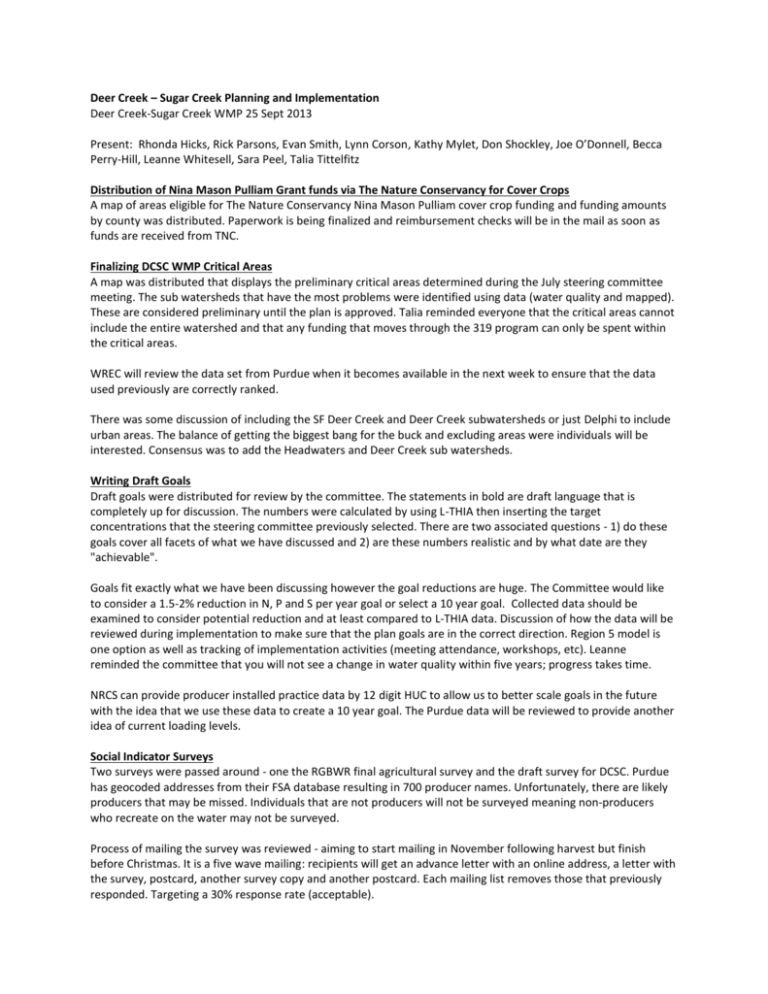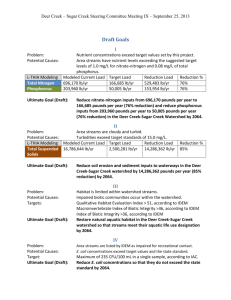Minutes
advertisement

Deer Creek – Sugar Creek Planning and Implementation Deer Creek-Sugar Creek WMP 25 Sept 2013 Present: Rhonda Hicks, Rick Parsons, Evan Smith, Lynn Corson, Kathy Mylet, Don Shockley, Joe O’Donnell, Becca Perry-Hill, Leanne Whitesell, Sara Peel, Talia Tittelfitz Distribution of Nina Mason Pulliam Grant funds via The Nature Conservancy for Cover Crops A map of areas eligible for The Nature Conservancy Nina Mason Pulliam cover crop funding and funding amounts by county was distributed. Paperwork is being finalized and reimbursement checks will be in the mail as soon as funds are received from TNC. Finalizing DCSC WMP Critical Areas A map was distributed that displays the preliminary critical areas determined during the July steering committee meeting. The sub watersheds that have the most problems were identified using data (water quality and mapped). These are considered preliminary until the plan is approved. Talia reminded everyone that the critical areas cannot include the entire watershed and that any funding that moves through the 319 program can only be spent within the critical areas. WREC will review the data set from Purdue when it becomes available in the next week to ensure that the data used previously are correctly ranked. There was some discussion of including the SF Deer Creek and Deer Creek subwatersheds or just Delphi to include urban areas. The balance of getting the biggest bang for the buck and excluding areas were individuals will be interested. Consensus was to add the Headwaters and Deer Creek sub watersheds. Writing Draft Goals Draft goals were distributed for review by the committee. The statements in bold are draft language that is completely up for discussion. The numbers were calculated by using L-THIA then inserting the target concentrations that the steering committee previously selected. There are two associated questions - 1) do these goals cover all facets of what we have discussed and 2) are these numbers realistic and by what date are they "achievable". Goals fit exactly what we have been discussing however the goal reductions are huge. The Committee would like to consider a 1.5-2% reduction in N, P and S per year goal or select a 10 year goal. Collected data should be examined to consider potential reduction and at least compared to L-THIA data. Discussion of how the data will be reviewed during implementation to make sure that the plan goals are in the correct direction. Region 5 model is one option as well as tracking of implementation activities (meeting attendance, workshops, etc). Leanne reminded the committee that you will not see a change in water quality within five years; progress takes time. NRCS can provide producer installed practice data by 12 digit HUC to allow us to better scale goals in the future with the idea that we use these data to create a 10 year goal. The Purdue data will be reviewed to provide another idea of current loading levels. Social Indicator Surveys Two surveys were passed around - one the RGBWR final agricultural survey and the draft survey for DCSC. Purdue has geocoded addresses from their FSA database resulting in 700 producer names. Unfortunately, there are likely producers that may be missed. Individuals that are not producers will not be surveyed meaning non-producers who recreate on the water may not be surveyed. Process of mailing the survey was reviewed - aiming to start mailing in November following harvest but finish before Christmas. It is a five wave mailing: recipients will get an advance letter with an online address, a letter with the survey, postcard, another survey copy and another postcard. Each mailing list removes those that previously responded. Targeting a 30% response rate (acceptable). The committee discussed the need to interview CFO/CAFO producers as they might not be willing to reply to this survey and interviews may need to be conducted with this population. Consider contacting the Carroll County Ag Association to encourage producers to know that the survey is coming and request that they respond. Check with other counties to see if they have a similar ag association. Consider including it in the Carroll County Comet (and other newspapers) and mention it at the public meeting. Response bias as also discussed - those individuals that are really positive towards conservation and those that are really negative toward government tend to answer surveys as well. People can be called to check their responses if this is a concern. Next meeting date: Thursday, November 14, 3 pm Flora Library. Public Meeting: October 23rd 6-8pm Delphi United Methodist Church Public Concern Agriculture run-off is contributing to the high nutrient concentrations and sedimentation (turbidity) within the Deer Creek Sugar Creek watershed. Flood prone ground is farmed causing additional sediment and nutrient loading to waterbodies in the Deer Creek-Sugar Creek watershed. Manure is being applied to throughout the watershed. Nitrogen concentrations exceed suggested levels. Phosphorus concentrations exceed suggested levels. There are limited buffers along Buck Creek which are contributing to poor water quality, and instable banks. Agriculture run-off is contributing to the high nutrient concentrations and sedimentation (turbidity) within the Deer Creek Sugar Creek watershed. Flood prone ground is farmed causing additional sediment and nutrient loading to waterbodies in the Deer Creek-Sugar Creek watershed. Livestock is negatively impacting water quality. There are unregulated animal farms within the watershed. Turbidity/sediment exceeds recommended levels by USEPA. Poor soil quality is present throughout the watershed. Stream bank erosion occurs along the waterbodies within the watershed. There are limited buffers along Buck Creek which are contributing to poor water quality, and instable banks Livestock are negatively impacting water quality. There are unregulated animal farms within the watershed. Fish populations have been negatively affected by the water quality. Macroinvertebrate populations have been negatively affected by the water quality. Fish populations have been negatively affected by the water quality. Macroinvertebrate populations have been negatively affected by the water quality. Nitrogen concentrations exceed suggested levels. Phosphorus concentrations exceed suggested levels. E. coli concentrations exceed the state of Indiana’s suggested level. Educational programs addressing conservation practices, recycling, climate change, and disposing of chemicals need to be developed. Problems Area streams have nutrient levels exceeding the suggested target levels of 1.0 mg/L for nitrate-nitrogen and 0.3 mg/L of total phosphorus. Turbidities exceed target standards of 10.4 NTU. Livestock have access to the stream. Impaired biotic communities occur within the watershed. Area streams are listed by IDEM as impaired Individuals lack knowledge of their impact on the watershed. Too few agricultural best management practices are located in the Deer Creek-Sugar Creek watershed. There are limited buffers along Buck Creek which are contributing to poor water quality, and instable banks. Stream bank erosion occurs along the waterbodies within the watershed. Limited agricultural best management practices








